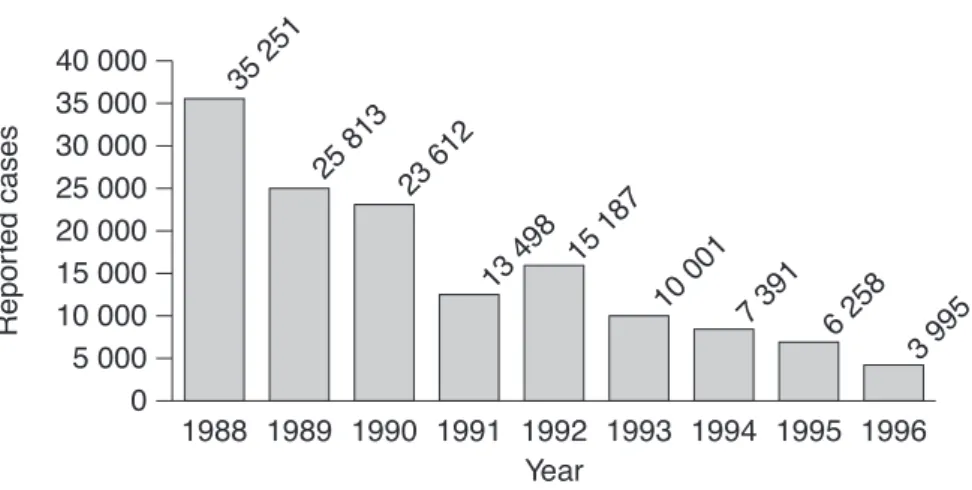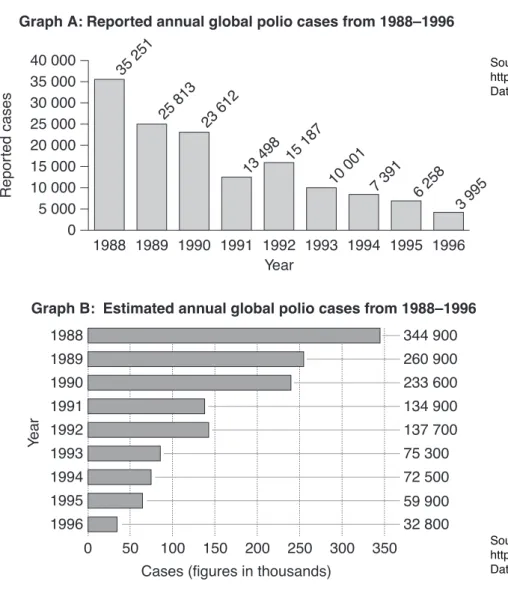7 How do cleanliness in food preparation and cleanliness in personal hygiene help fight disease. 10 Which of the following answers correctly identifies a source of variation in both asexual and sexual reproduction. In the process illustrated in the diagram, water from xylem (A) causes a buildup of pressure.
16 Which of the following shows the correct sequence of steps in the interaction between T cells (lymphocytes) and B cells (lymphocytes). These spaces provide guidance on the expected length of the response. a) Identify TWO methods used to treat drinking water to reduce the risk of infection.
Part B (continued)
6 marks)
In evaluating the effectiveness of the global polio vaccination program begun in 1988, a student collected charts A and B from two reputable sources. a) Identify TWO similarities and TWO differences between the information contained in Charts A and B. b) Recommend TWO additional types of data that could be used to evaluate the effectiveness of the global polio vaccination program. Describe at least FOUR features of an epidemiological study that could be used to identify the cause of this disease. The skin contains stem cells as well as epidermal, blood vessel, fat and muscle cells.
New research suggests that stem cells taken from a patient's skin can be used to create red and white blood cells for that patient in the laboratory. The production of new, improved artificial blood seems a likely outcome. a) Describe how gene expression in skin stem cells is related to the maintenance of health after skin breakdown. You are required to plan and carry out a first-hand investigation to identify microbes in food or water.
Scientists recorded the body temperature of 50 reptiles of the same species on the same day. The chemical composition of the human enzyme differs from that of pathogenic bacteria by two amino acids.
The diagram below shows a microscopic view of a neuron. i) Which structures are labeled A and B. In answer 2, clearly state which is A and which is B. ii) Identify the role of structure B. b) Explain why some stimuli do not elicit an action potential.
Answer parts (d)–(e) in Section II Answer Book 2. d) Compare the hearing of THREE mammals, including humans, with possible causes of their hearing differences. e) Explain how hearing aid and cochlear implant technologies help hearing. Refer to the anatomy and function of the human ear and the role of the brain in coordinating responses to stimuli. The diagram below shows a recombinant DNA technique. i) What is represented by the components labeled A and B. State clearly in your answer what is A and what is B. ii) Identify the process shown in the diagram.
One type of ant has been observed cleaning the surface of the soil for 5 meters around its colony and burying grass seeds there. When the seeds ripen, the ants collect the seeds for food and keep some seeds for next year's crop. A ten-year study has shown that the average size of grass seeds has increased by 5%. i) Outline the difference between qualitative and quantitative observations, using examples from the text above. ii) Explain why the activity of ants can be interpreted as biotechnology.
Answer parts (d)–(e) of the question in Section II Answer Booklet 2. d) Explain the risks and benefits to society of the use of recombinant DNA technologies. e) Enzymes have been developed from bacteria that remove contaminating insecticides and herbicides from waterways. Explain how the technologies you have studied in this option can be applied to the development and production of such enzymes. Original DNA AAC TCG GTC AAT ATG Mutation 1 AAC TCC GTC AAT ATG Mutation 2 AAC TCG GTA ATA TGC. i) What type of mutations are Mutation 1 and Mutation 2. Clearly indicate in your answer what Mutation 1 is and what Mutation 2 is. ii) Using the information provided in the table, what is the effect of Mutation 1.
Original DNA AAC TCG GTC AAT ATG Mutation 1 AAC TCC GTC AAT ATG Mutation 2 AAC TCG GTA ATA TGC. i) Which types of mutations are Mutation 1 and Mutation 2. Please indicate clearly in your answer which Mutation 1 and which Mutation 2 is. ii) What is the effect of Mutation 1 using the information in the table. b) Explain how children with different ABO and Rhesus blood types can be descendants of the same parents. The scientist claims that “these chickens are not genetically modified because they come from a natural breed and are not cloned.” i) Give an overview of the difference between selective breeding and animal cloning. ii) Discuss the scientist's claim using your knowledge of selective breeding. Answer parts (d)–(e) in Section II Answer Booklet 2. d) Discuss the use of the Human Genome Project and traditional inheritance studies as ways to identify the location of harmful genes. e) The origin of the dingo (a native Australian dog) is uncertain.
It is commonly classified as Canis familiaris dingo, a subspecies of the domestic dog, Canis familiaris. It has recently been suggested that the dingo should be reclassified as Canis lupus dingo to reflect a closer relationship to the Asian wolf, Canis lupus. Explain how the technologies you studied in this option can be applied to identify the relationships between these species. A).
The diagrams show labeled fossil layers that were found at different locations within the region. i) Which rock layers are the oldest and which are the youngest in this area. ii) Name the relative dating technique used in your answer to part (i).
These fossils have been dated to 18,000 years ago and were found in sediment that contained stone tools and cooking hearths. The size of each adult organism was approximately the same as a three-year-old modern human. The cooking hearths contained charred bones of game species, each estimated to weigh more than 1,000 kilograms.
Stone tools include knives, spearheads, and cutting and chopping implements. i) Outline the fossil evidence from this description suggesting the advanced cultural development of Homo floresiensis. ii) Discuss the validity of the classification of Homo floresiensis as a species separate from other known fossil hominids. Compare early and current Homo sapiens by explaining the mechanisms of biological evolution. ii) Explain why there is greater genetic diversity between human populations in Africa than between human populations in other continents. e) Insectivorous microbats and fruitivorous megabats are classified as members of the order Chiroptera. Lemurs are fruit and leaf eaters and are classified as members of the order Primates.
Scientists have recently hypothesized that megabats are closer in evolutionary terms to lemurs than to microbats. Answer parts (a)–(c) in Section II Answer Booklet 1. The diagram outlines a biochemical pathway. ii) What are molecules A and B. Clearly indicate in your answer what A is. b) Describe the location of the site of light absorption during photosynthesis.
Answer parts (d)–(e) in Section II Answer Booklet 2. d) Describe how Mayer's conclusion about photosynthesis brought together ideas from the work of earlier scientists. e) A new chlorophyll, chlorophyll E, was recently discovered in cyanobacteria by Australian scientists. As a member of the science team, your role is to identify the subcellular location of the new chlorophyll, extract it, separate it from other chlorophylls, and analyze its properties. Explain the technologies you will use to perform your role on the science team.

